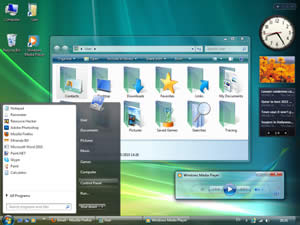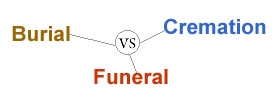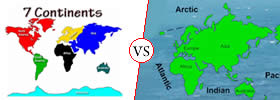Difference between Windows 7 and Windows Vista
Key Difference: Windows 7 and Windows Vista are two operating systems that are offered by Microsoft for running on their PCs and Laptops. Windows 7 offered a new look, layout and is considered to be a polished version of the Vista. Windows Vista is the operating system that sought to revamp the whole look of Windows, but was considered as an unfinished with many features not working properly or causing the computer to lag or crash.
Windows Vista and Windows 7 are two operating systems launched by Microsoft. These two operating systems brought about big changes from the childish and really plain OS that was offered by the company. Vista brought about many changes in terms of aesthetics, security and many other aspects of the operating system. It gave Windows XP a whole new look, a more futuristic look. It also made the system more user-friendly with the new shortcuts, easy search results, etc. However, it also came plagued with many bugs and hardware issues. Though, these issues were resolved in security patches, it had already lost its fan following. Windows 7 offers many of the same features as Vista; however, it has upgraded those features and removed many bugs from the system.
 Windows 7 was launched in February 2011 as a way to make the computer more user-friendly, as well as offer some upgrades on the already present Windows Vista system. While, Vista sought to offer many new features, Windows 7 was launched as an upgrade that was designed to work with Vista-compatible applications and hardware. The main change that was offered with Windows 7 was the new Taskbar that was dubbed as ‘Superbar’. The main reason for the launch of Windows 7 was to make a more user-friendly windows system and incorporate the new features of Windows Vista that were appealing to the people, but failed when Vista tanked.
Windows 7 was launched in February 2011 as a way to make the computer more user-friendly, as well as offer some upgrades on the already present Windows Vista system. While, Vista sought to offer many new features, Windows 7 was launched as an upgrade that was designed to work with Vista-compatible applications and hardware. The main change that was offered with Windows 7 was the new Taskbar that was dubbed as ‘Superbar’. The main reason for the launch of Windows 7 was to make a more user-friendly windows system and incorporate the new features of Windows Vista that were appealing to the people, but failed when Vista tanked.
The new features that were introduced on Windows 7 included: extended support for Vista themes, gadgets side bar that allowed users to add calendar, clock and other such gadgets on the desktop, Windows Explorer supports Libraries (which shows all virtual folders and content in a unified view), changes to the Start Menu, shut down button has been altered with more options only available if the arrow is clicked, jump lists on the taskbar when hovered on right-clicked on, search box has been extended to support items in Control Panel. Additional features include Aero Snap and Aero Shake. When Windows is dragged to the top right hand side of the screen it automatically maximized and minimizes when it is pulled away. In Aero Shake, shaking a window on the screen will only keep the shaken window active and the rest of windows will minimize. Additional keyboard shortcuts have been introduced.
Diffen.com lists the shortcuts as:
- Win+Space operates as a keyboard shortcut for Aero Peek.
- Win+Up and Win+Down are new shortcuts for Maximize and Restore/Minimize.
- Win+Shift+Up vertically maximises the current window
- Win+Left and Win+Right snap the current window to the left or right half of the current display; successive keypresses will move the window to other monitors in a multi-monitor configuration.
- Win+Shift+Left and Win+Shift+Right move the current window to the left or right display.
- Win+ + and Win+ - (minus sign) zoom the desktop in and out.
- Win+Home operates as a keyboard shortcut for Aero Shake.
- Win+P shows an "external display options" selector that gives the user the choice of showing the desktop on only the computer's screen, only the external display, on both at the same time (mirroring), or on both displays with independent desktops (extending).
- Shift + Click, or Middle click starts a new instance of the application, regardless of whether it's already running.
- Ctrl + Shift + Click starts a new instance with Administrator privileges; by default, a User Account Control prompt will be displayed.
- Shift + Right-click shows the classic Window menu (Restore / Minimize / Move / etc); right-clicking on the application's thumbnail image will also show this menu. If the icon being clicked on is a grouped icon, the classic menu with Restore All / Minimize All / Close All menu is shown.
- Ctrl + Click on a grouped icon cycles between the windows (or tabs) in the group.
Windows 7 was launched in six different editions: Home Premium Edition, Professional Edition, Ultimate Edition, Starter Edition, Enterprise Edition and Home Basic Edition. The first three editions were available for retail sale for consumers, while the Starter edition was preinstalled by OEM, the Enterprise edition only by volume licensing, and Home Basic only to certain developing countries' markets. The Windows 7 was a hit with many of the Microsoft customers and was used widely as an operating system. The Windows 7 required a 1 GHz processor, 1 GB RAM, DirectX 9 graphics processor with WDDM driver model 1.0, 16-20 GB (depending on architecture) free disk space and a DVD-ROM drive.
 Windows Vista is an operating system that was released worldwide in January 2007 as an upgrade to the Windows XP. The new OS offered an upgraded graphical user interface and a whole new look. This was the first time that the company introduced the Aero visual style with the glass look. The Vista also had a new Taskbar, a new search component, subsystems, multimedia tools and much more. The main aim of Vista was to increase the level of communication between machines, simplify sharing and allowing software developers to write applications without the traditional Windows APIs.
Windows Vista is an operating system that was released worldwide in January 2007 as an upgrade to the Windows XP. The new OS offered an upgraded graphical user interface and a whole new look. This was the first time that the company introduced the Aero visual style with the glass look. The Vista also had a new Taskbar, a new search component, subsystems, multimedia tools and much more. The main aim of Vista was to increase the level of communication between machines, simplify sharing and allowing software developers to write applications without the traditional Windows APIs.
The company also sought to increase the security on the system, with measures such as User Account Control. This system gave prompts every time an application tried to make changes or access a system. However, the constant prompting became more of a nuisance for many users. Though, many new features received positive reviews, the operating system itself was considered to be a huge failure, with many people to continuing to stick to the XP, rather than upgrade to the Vista. Windows Vista was criticized for issues such as high system requirements, more restrictive licensing terms, inclusion of a number of new digital rights management technologies, lack of compatibility with some pre-Vista hardware and software and the number of authorization prompts for User Account Control.
The higher system requirements demanded by Vista resulted in performance troubles. If a user performed a straight upgrade without new hardware, it resulted in the system lagging or crashing. Higher RAM was required and 1 GB RAM was proving too slow for the system. Vista also become sluggish when too much RAM was used and it also affected start up and shut down times. Windows Vista has been created by many enthusiasts as being the system that brought around many great changes and brought a whole new look to Windows. The company has stopped supporting Vista as of April 2012; however, extended support is expected to last until 2017.
|
|
Windows 7 |
Windows Vista |
|
License |
Proprietary commercial software |
Proprietary commercial software |
|
Worldwide Release |
October 22, 2009 |
January 30, 2007 |
|
Stable release |
February 22, 2011 |
April 28, 2009 |
|
Kernel type |
Hybrid |
Hybrid |
|
Platform support |
IA-32 and x86-64 |
IA-32 and x86-64 |
|
Preceded by |
Windows Vista |
Windows XP |
|
Succeeded by |
Windows 8 |
Windows 7 |
|
Physical Memory Limits |
2 – 192 GB depending on the version and architecture. |
1-128 GB depending on the version and architecture. |
|
Processors |
32 for 32-bit, 256 for 64-bit |
32 for 32-bit, 64 for 64-bit |
|
New Features |
|
|
|
Removed Features |
|
|
Image Courtesy: fediafedia.deviantart.com, geek.com









Add new comment